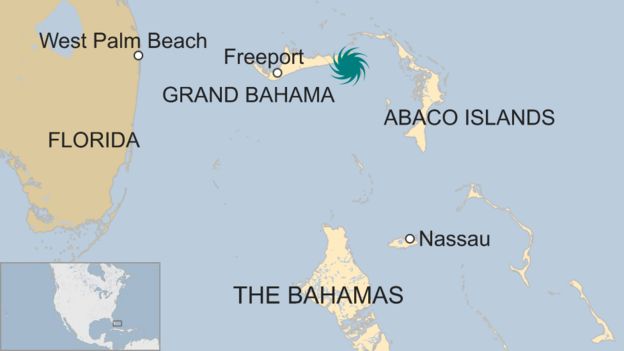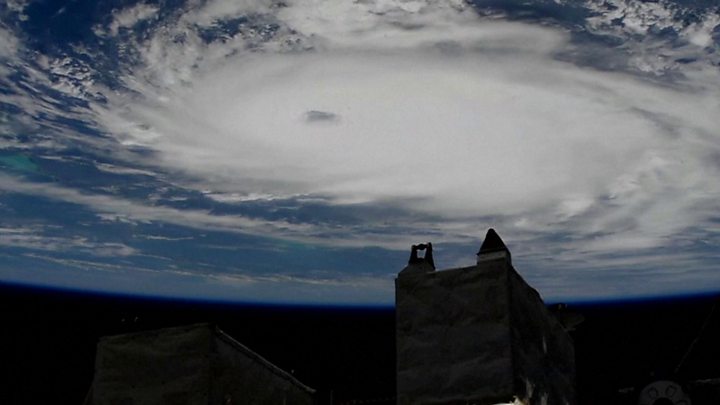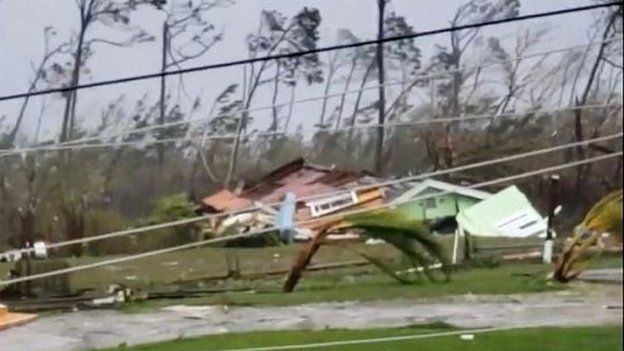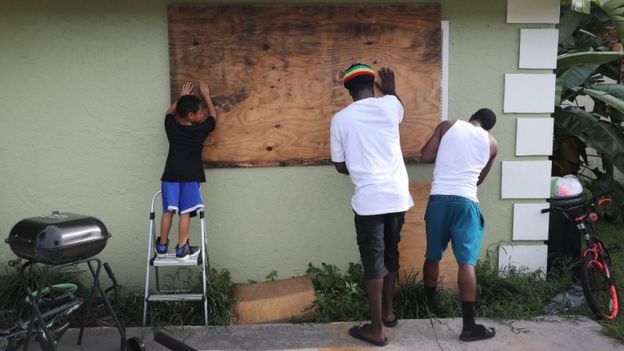
The most powerful storm to hit the Caribbean islands of the Bahamas since records began has torn roofs from buildings and caused severe flooding.
The slow-moving, category five Dorian – the second-strongest Atlantic hurricane on record – has sustained winds of up to 180mph (285km/h).
A “life-threatening” storm surge of 23ft (7m) is predicted in places.
The hurricane is moving slowly westwards and may hit areas of the eastern US seaboard.
The US states of Florida, Georgia, North and South Carolina have all declared states of emergency.
What’s the latest from the Bahamas?
The National Hurricane Center said that at 03:00 GMT, Dorian was located on the eastern edge of Grand Bahama, having made landfall earlier on the Abaco islands, which are just to the east.
Both chains are in the north of the Bahamas archipelago. Grand Bahama is only 100km (60 miles) east of West Palm Beach in Florida.
Dorian is slow-moving, travelling west at only 9km/h (6mph).

There was little information overnight from the affected Bahamas islands amid power cuts and limited internet access. The Abaco islands were reported under water after the storm hit on Sunday, with a storm surge of up to 7m (23ft).
Government officials said they had seen footage from Abaco of floodwaters the height of a car roof, and homes without roofs.
High winds and torrential rainfall have also struck Grand Bahama.
Residents posted footage showing floodwaters engulfing some homes after high winds had struck. Videos also show capsized boats floating in floodwaters filled with debris.
Joy Jibrilu, director general of the Ministry of Tourism and Aviation, said on Sunday afternoon: “It’s devastating. There has been huge damage to property and infrastructure. Luckily, no loss of life reported.”
However, Eyewitness News later carried an interview with a grandmother who said her eight-year-old grandson had drowned on the Abaco Islands.

The government has opened 14 shelters and names dozens of churches, schools and other buildings on its official lists of emergency shelters.
But as sites become full, there is concern that people will be forced to take refuge in other places that aren’t listed to receive food and water from the government.
How has the Bahamas prepared?
The country is one of those most regularly hit by hurricanes, and homes are required to be reinforced to withstand the winds of a category four storm.

Prime Minister Hubert Minnis did announce an evacuation order for parts of Grand Bahama and the Abaco Islands, All tourists were asked to leave.
But officials expressed dismay that some people had chosen to stay.
Mr Minnis said: “I can only say to them, that I hope this is not the last time they will hear my voice and may God be with them.”
The visibly upset prime minister said in a news conference on Sunday: “This is probably the most sad and worst day of my life. We’re facing a hurricane… that we’ve never seen in the history of the Bahamas.”
What about the US?
Although Dorian is currently heading westwards, it is forecast to make a gradual turn north-west, taking it along the eastern US seaboard, making its landfall point, if any, uncertain.


President Donald Trump cancelled a planned trip to Poland last week and has met emergency management officials.
He told reporters on Sunday that the storm “looks monstrous” and the US east coast would “be ultimately impacted and some of it very, very severely”.
Dorian has grown larger in size, with hurricane-force winds extending up to 45 miles (75km) from the storm’s centre.

President Trump has issued a federal state of emergency for Florida, and the state’s governor, Ron DeSantis, has activated 2,000 National Guard troops, with another 2,000 on standby.
Mr DeSantis warned people not to be complacent following the change in the storm’s predicted path. “This storm at this magnitude could really cause massive destruction,” he said.
Popular attractions, including Disney World in Orlando, have said they are “closely monitoring” the storm. Miami has ordered the removal of electric rental scooters from the streets to avoid them becoming projectiles.
South Carolina on Sunday issued a mandatory evacuation of the entire coast, effective of noon on Monday and affecting 830,000 people. Georgia then followed suit.

How destructive are category five hurricanes?
With sustained wind speeds of at least 157mph they are relatively rare, although four other storms reached this level in the last three years:
- Michael made landfall in Florida last year, causing 59 deaths and about $25bn (£20bn) in damage. It was the strongest storm to make landfall in the US in 26 years and only the fourth hurricane of this category to have hit the country
- Maria, in 2017, devastated the island of Dominica, where it was responsible for 31 deaths, before causing widespread destruction in Puerto Rico as a category four hurricane. A study said nearly 3,000 people had died there as a result
- Irma, also in 2017, made seven landfalls, four of which were category five, across the northern Caribbean Islands, before making landfall in the Florida Keys as a category four storm. It was one of the strongest and costliest hurricanes on record and caused 47 deaths in total
- Matthew, in 2016, was a category five storm that later made landfalls in Haiti, Cuba and Grand Bahama Island as a major hurricane. It was the deadliest hurricane in more than a decade, with 585 deaths, more than 500 of them in Haiti alone
Source: US National Hurricane Center



